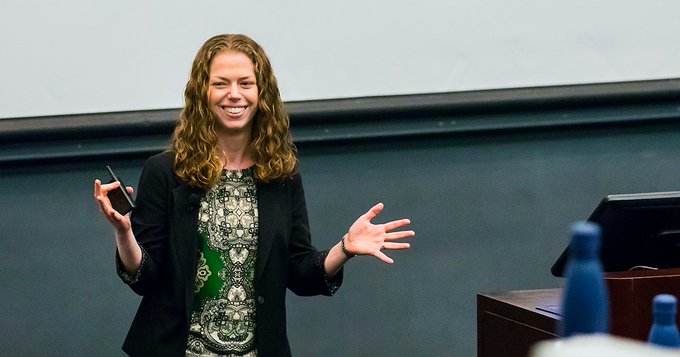Behavior Change for Good unveils effective strategies to boost vaccination rates
The Behavior Change for Good Initiative (BCFG) at the Wharton School and the School of Arts & Sciences of the University of Pennsylvania, in collaboration with the Penn Medicine Nudge Unit, today released findings from two of the largest-ever research studies aimed at increasing vaccine adoption.
Conducted with Walmart and two regional health systems—Penn Medicine and Geisinger—these studies reveal that simple communications that reminded individuals a flu shot was “waiting” or “reserved” for them proved most effective, boosting vaccination rates by up to 11%. The promising results can be adapted to encourage COVID-19 vaccinations.
“While the vaccines are different, we face the same behavioral challenges in encouraging uptake of the flu and COVID-19 vaccinations,” says Katy Milkman, Wharton professor, BCFG co-director, and lead author on both studies. “Rather than convincing the skeptics, we focused on encouraging people who want the vaccine to actually receive it. Our results suggest a promising way to encourage COVID-19 vaccinations at scale. We can potentially help save lives for less than 10 cents per person.”
These studies tested the effectiveness of behaviorally informed nudges delivered via SMS to increase vaccination rates of flu shots among two populations: approximately 700,000 Walmart pharmacy patients and approximately 50,000 primary care patients at Penn Medicine and Geisinger. The rationale for nudging people toward better decisions is simple and well-supported; most people intend to do what’s best for their health, for example, getting a vaccine, but have trouble garnering the motivation to take action. These text messages were designed to close this “intention-action gap” by providing the necessary encouragement to follow-through on best intentions.
The significant increase in vaccination rates generated by using the “reserved for you” reminder messaging is especially remarkable given the very low cost of these SMS-based interventions.
“The COVID-19 vaccination effort is still in its early stages. Health systems and public health agencies around the world have already implemented campaigns to promote vaccination,” says Mitesh Patel, Penn Medicine professor and director of the Penn Medicine Nudge Unit. “Our results reveal opportunities to make simple changes to the wording in those campaigns that could nudge vaccination rates higher and help us end this pandemic faster.”
Penn Medicine and Geisinger study
At Penn Medicine and Geisinger, BCFG conducted its study in collaboration with Christopher Chabris and Michelle Meyer (co-directors of the Geisinger Behavioral Insights Team). In the fall of 2020, close to 50,000 patients received one of 19 different messages prior to a healthy visit to their primary care provider. In the new study, roughly a third of the messages BCFG tested significantly increased flu shot uptake.
The top performing message set—designed by Jon Bogard, Craig Fox, Jehan Sparks, and Megan Weber from the University of California at Los Angeles, and Matt Hilchey, Melanie Kim, Dilip Soman, and Renante Rondina from the University of Toronto, in collaboration with BCFG—boosted vaccination rates by 11%.
It involved two reminder texts sent 72 hours and 24 hours prior to a patient’s appointment. The first message encouraged patients to request a flu shot at their upcoming appointment to protect the health of themselves and their families, and the second reminded patients that a flu shot had been reserved for their appointment. In this study, the most effective messages were unsurprising and lacked interactive components, simply reminding patients that a flu shot was reserved for them at their doctor’s office. Messages that were more clever or informal, such as sharing a joke about the flu, were less effective.
Read the full report at “A mega-study of text-based nudges encouraging patients to get vaccinated at an upcoming doctor’s appointment.”
Walmart study
At Walmart, BCFG tested 22 different SMS messages in September 2020 with more than 700,000 pharmacy patients who had agreed to receive text messages from their pharmacy and received a flu shot at Walmart during the prior flu season.
Based on early analyses, the new study yielded strikingly similar results to the study conducted with Penn Medicine and Geisinger patients. The top-performing message set, also designed by Jon Bogard and Noah Goldstein from the University of California at Los Angeles, in collaboration with BCFG, informed patients that they could get a flu shot at Walmart, and the second message—sent three days later—reminded them that a flu shot was “waiting for you.”
Read the full report on early results from this study with Walmart at “A mega-study of text-message nudges encouraging patients to get vaccinated at their pharmacy.”
Across both studies, conveying that a flu shot was set aside or reserved for a patient was the most effective messaging strategy. Alison Buttenheim of Penn’s School of Nursing and Gretchen Chapman of Carnegie Mellon University, in collaboration with BCFG, designed a test to evaluate the hypothesis that conveying a shot reserved for a patient could help close the intention-action gap.
“Telling a person the flu shot is ‘reserved for you’ suggests that this particular dose of the vaccine already belongs to them, and if they don’t claim it, they’ll actually be losing something,” Buttenheim says. “So it invokes loss aversion, as well as a sense of reciprocity—the provider has gone to the trouble of setting aside the vaccine dose, and it would be rude not to take it. Gretchen was also eager to frame getting the flu shot as a default: The flu shot is waiting for you.”
BCFG hopes these strategies for designing low-cost and scalable nudges will support COVID-19 vaccination efforts and help curb the spread of this devastating virus.
“Fighting the COVID-19 pandemic requires all hands on deck,” says Angela Duckworth, the Rosa Lee and Egbert Chang Professor in the School of Arts & Sciences and Wharton, and BCFG co-director. “I am thrilled at the potential of our results to support the heroic efforts we have already seen from other academics, industry professionals, and frontline health care workers.”

